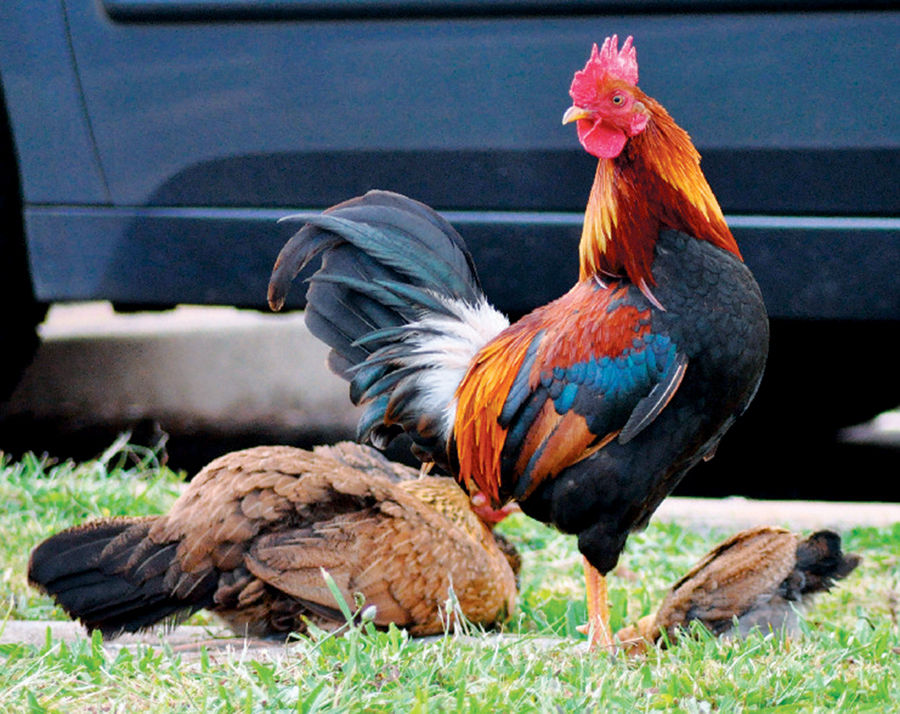Just how famous are Kauai’s chickens? Enough for the New York Times to write a lengthy report about them. The story by Kenneth Chang, “In Hawaii, Chickens Gone Wild,” was published Monday. “On the island of Kauai, chickens have not
Just how famous are Kauai’s chickens?
Enough for the New York Times to write a lengthy report about them.
The story by Kenneth Chang, “In Hawaii, Chickens Gone Wild,” was published Monday.
“On the island of Kauai, chickens have not just crossed the road,” Chang wrote. “They are also crowing in parking lots, hanging out at beaches and flocking in forests.
“They’re absolutely everywhere,” said Eben J. Gering, an evolutionary biologist at Michigan State University who has been studying these truly free-range birds. “They seem to be living a whole diversity of lifestyles, from eating garbage and cat food to being fed by tourists at the beach to foraging on native arthropods.”
Chang goes on, in detail, to report on a paper published last month in the journal Molecular Ecology. It describes how “Dr. Gering and his colleagues tried to untangle the genetic history of the Kauai feral chickens, which turn out to be not only a curiosity for tourists, but also a window into how humans domesticated wild animals. The reservoir of genetic traits could also prove useful for breeders.”
The article is long and bogs down with sentences like, “Later research, examining DNA from chicken bones dating back 2,000 years recovered from European archaeological digs, found that the mutation was not always ubiquitous. That disproved the notion that the mutation was crucial to domestication.”
It points out that the chickens population increased after hurricanes Iwa in 1982 and Iniki in 1992.
“But the genealogy of chickens on Hawaii stretches back much farther,” Chang wrote. “The first people there were Polynesians, who embarked on long ocean voyages to specks of islands in the expanse of the Pacific. They arrived at Hawaii at least 800 years ago.
“Wherever the Polynesians went, they took their chickens, which were much like the ancestral red junglefowl.”
Chang reports that in the new research, the scientists sequenced DNA from 23 chickens from eight regions of Kauai. As the influx of farm chickens encountered the older Polynesian red junglefowl population, Dr. Gering wondered, “How is that population evolving?”
Here is the answer:
“The mitochondrial DNA of a few of the chickens matched that of the Polynesian chicken bones from the Kauai cave; more had the DNA of recent European breeds. Not all of the feral chickens had the mutated thyroid hormone receptor of modern domesticated chickens. The birds’ appearances also indicate that ancient traits persist. Some look as if they have just walked off the farm, but many others, with burnt orange and black plumage for the males, look like red junglefowl from the forests of India or Vietnam.
That explains it.
The article might have more detailed information than most people would want to read, but it does shed more light on their genetics and ancestry, if that is of interest to you.
Dr. Gering speculated that until recent decades, the Kauai chickens were largely like the ones that the Polynesians brought long ago, living in small parts of the island and modest in number. Then they began mating with the escaped farm chickens or their descendants, with greater fecundity and a wider range of habitats, Chang wrote.
“We think that’s why we’re seeing them now at Walmart and all over the place,” Dr. Gering said in the article.


